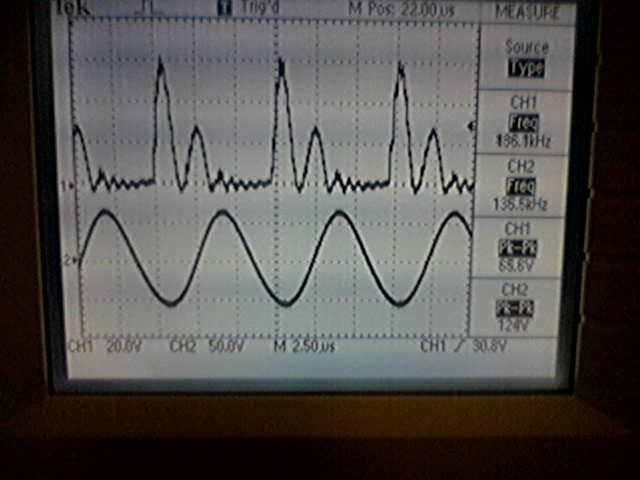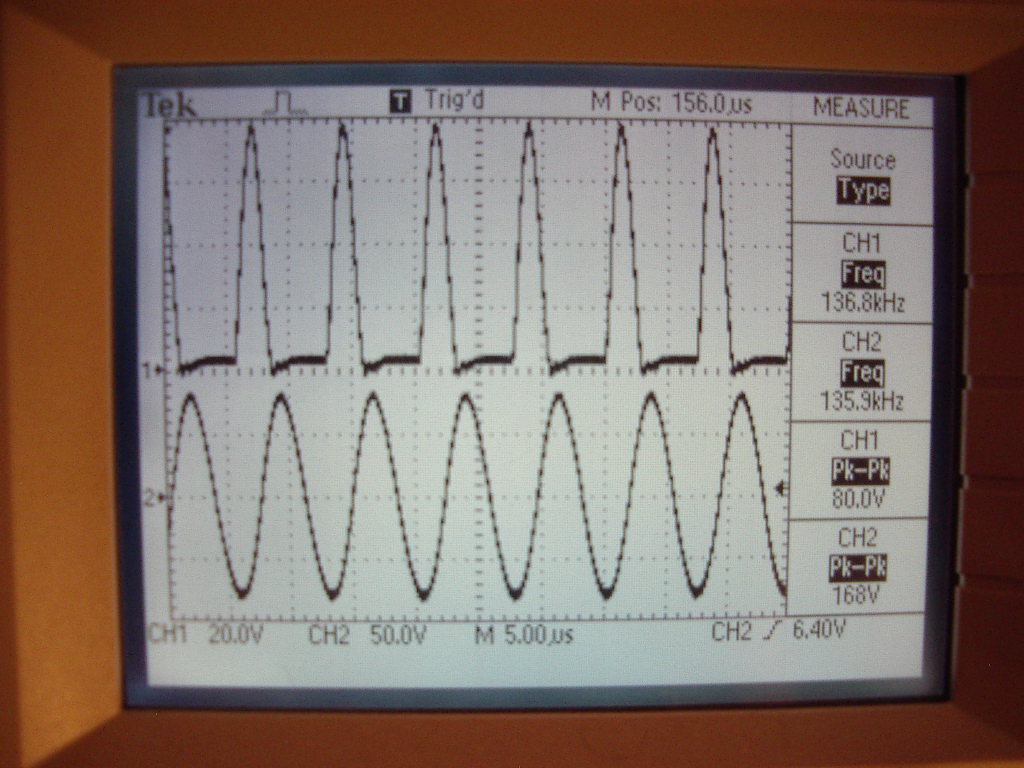VK1SV 136 kHz page
IRF540 amplifier for LF (VE7SL design)
I am working on a MOSFET (IRF540) amplifier for use in the
new "top band", 136 kHz. The basis of my design is the
VE7SL transmitter.
 This is a picture of the drain voltage (trace 1) and the voltage on
the 50 Ohm dummy load, after the low pass filter (trace 2). I can
get about 40 W RMS without any serious heat being generated by the
FET.
This is a picture of the drain voltage (trace 1) and the voltage on
the 50 Ohm dummy load, after the low pass filter (trace 2). I can
get about 40 W RMS without any serious heat being generated by the
FET.
IRF640 amplifier for LF (DF3LP design)
I made yesterday a copy of the DF3LP simple low power transmitter
(details
here). It works very well! As you can see in the oscilloscope display
below, the drain voltage looks very clean (top trace) and the dummy load
voltage (bottom trace) indicates a very healty almost 70 W RMS (or so). The
FET was powered with 1bout 18 V when this picture was taken.
 The prototype of the DF3LP copy can be seen below. I made some changes
to the actual design, specifically to the capacitors and the coil at the
drain circuit of the power FET. The values suggested by DF3LP were the starting
point and only small changes were made in order to fine tune the circuit.
The efficiency measured at 12 V is 75% and I believe it is slightly better
at 18 V. I also used an IRF720 at the driver stage instead of the suggested
IRF630/IRF640 because that's all I had in my junk box.
The prototype of the DF3LP copy can be seen below. I made some changes
to the actual design, specifically to the capacitors and the coil at the
drain circuit of the power FET. The values suggested by DF3LP were the starting
point and only small changes were made in order to fine tune the circuit.
The efficiency measured at 12 V is 75% and I believe it is slightly better
at 18 V. I also used an IRF720 at the driver stage instead of the suggested
IRF630/IRF640 because that's all I had in my junk box.
 I am quite happy with the results so far, so I am looking at the possibility of
using more than one FET (parallel) in the output stage, for higher output.
I am quite happy with the results so far, so I am looking at the possibility of
using more than one FET (parallel) in the output stage, for higher output.
136 kHz signal source
My main signal source for the 136 kHz transmitter is based on a divide
by 200 circuit and a 27 MHz crystal. In fact I have a number of
27 MHz ex CB crystals which allow me to change my frequency as needed.
I have also added a second input (selectable by a switch at the front
of the transmitter panel) which accepts a 13.6 MHz ~10 dBm sine wave and
divides it by 100 to produce a signal in the band. This is handy when
a very accurate frequency is needed, for example when we have an "LF activity
day", which is normally done on 135.920 kHz. I don't have a crystal that
produces that frequency so I use my external signal generator tuned on
13.6 MHz. This setup has proven very stable and suitable for slow QRSS.

